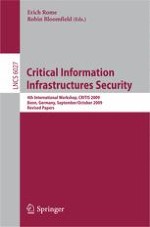2010 | Book
Critical Information Infrastructures Security
4th International Workshop, CRITIS 2009, Bonn, Germany, September 30 - October 2, 2009. Revised Papers
Editors: Erich Rome, Robin Bloomfield
Publisher: Springer Berlin Heidelberg
Book Series : Lecture Notes in Computer Science
